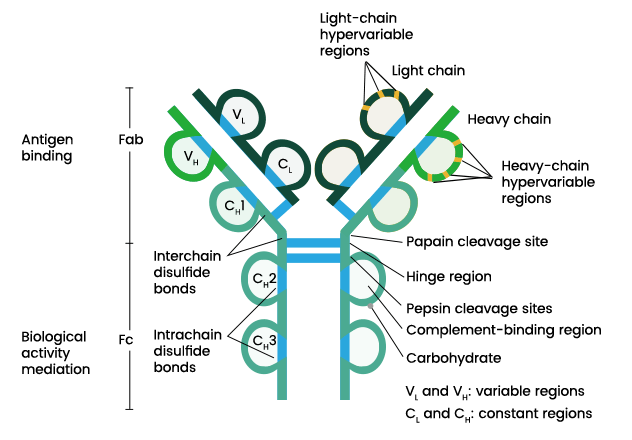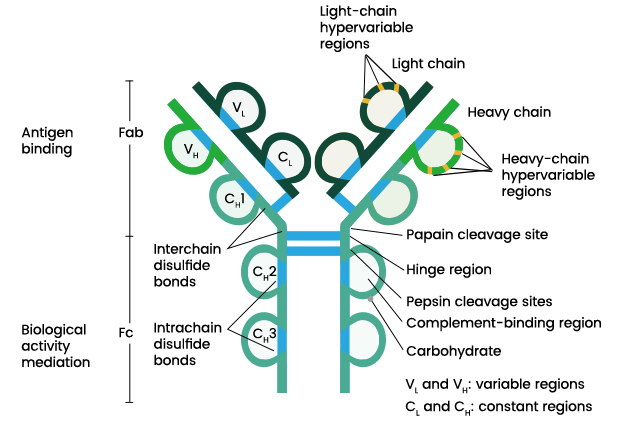
ABSTRACT:
In this article, we will discuss about the properties, structure and function of antibodies. Antibodies, also known as immunoglobulins. These are essential components of the immune system that play a crucial role in defending the body against harmful pathogens. These Y-shaped proteins produced by specialized white blood cells called B cells and designed to recognize and neutralize specific foreign substances, known as antigens. We will also provide related references to understand the concept deeply.
INTRODUCTION OF PROPERTIES, STRUCTURE AND FUNCTIONS OF ANTIBODIES:
Antibodies, also known as immunoglobulins. These proteins produced by the immune system in response to the presence of foreign substances called antigens. They play a crucial role in the immune response by recognizing and binding to specific antigens, such as bacteria, viruses, or toxins, to neutralize or eliminate them from the body. Antibodies Y-shaped molecules composed of two heavy chains and two light chains. They have specific binding sites that can recognize and bind to antigens with high specificity. These binding triggers various immune responses, such as activating complement proteins to destroy the antigen, marking the antigen for phagocytosis by immune cells, or blocking the antigen’s ability to infect cells. Antibodies can also provide long-term immunity by “remembering” specific antigens, allowing the immune system to respond more rapidly and effectively upon subsequent exposure to the same antigen.
PROPERTIES, STRUCTURE AND FUNCTIONS OF ANTIBODIES:
1. PROPERTIES OF ANTIBODIES:
a) SPECIFICITY:
Antibodies exhibit an extraordinary level of specificity, enabling them to recognize and bind to a particular antigen with high precision. This specificity arises from the unique structure of the antigen-binding region, known as the variable region, which can recognize and bind to a specific antigenic determinant, or epitope.
b) DIVERSITY:
The immune system possesses an extensive repertoire of antibodies capable of recognizing an immense range of antigens. This diversity is achieved through a process called somatic recombination, where gene segments encoding the variable region of the antibody are rearranged randomly during B cell development.
c) AFFINITY AND AVIDITY:
Antibodies exhibit varying degrees of affinity, which refers to the strength of the binding interaction between an antibody and its antigen. Additionally, multiple binding sites on an antibody molecule allow for increased avidity, which is the overall strength of binding between an antibody and its antigen.
d) IMMUNOGENECITY AND OPSONIZATION:
Antibodies can stimulate an immune response when they bind to antigens. This immune response can involve the activation of other immune cells, such as T cells, and the production of more antibodies. Antibodies can coat pathogens, marking them for destruction by immune cells such as macrophages and neutrophils. This process is called opsonization and enhances the clearance of pathogens from the body.
e) NEUTRALIZATION AND COMPLEMENT ACTIVATION:
Antibodies can neutralize pathogens by binding to their surface and preventing them from infecting host cells. This can block the entry of viruses into cells or inhibit the activity of bacterial toxins. Antibodies can activate the complement system, a group of proteins that help to eliminate pathogens. Activation of the complement system can lead to the formation of membrane attack complexes, which can directly kill pathogens.
f) MEMORY, ISOTYPE SWITCHING AND HALF LIFE:
After an initial exposure to an antigen, the immune system can produce memory B cells that can quickly generate a strong antibody response upon re-exposure to the same antigen. This memory response provides long-term protection against future infections. Antibodies can switch their isotype, or class, depending on the type of immune response needed. Different antibody isotypes have different effector functions and can activate different immune mechanisms. Antibodies have a relatively long half-life in the bloodstream, allowing them to circulate and provide prolonged protection against pathogens. The half-life can vary depending on the antibody isotype.
2. STRUCTURE OF ANTIBODIES:
Each antibody molecule is essentially identical to the antigen receptor of the B cell that produced it. The basic structure of these proteins consists of two pairs of polypeptide chains that form a flexible Y shape. The stem of the Y consists of one end of each of two identical heavy chains. While each arm is composed of the remaining portion of a heavy chain plus a smaller protein called the light chain.
The two light chains also are identical. Within particular classes of antibodies, the stem and the bottom of the arms are fairly similar and thus are called the constant region. The tips of the arms, however, are highly variable in sequence. It is these tips that bind antigen. Thus, each antibody has two identical antigen-binding sites. One at the end of each arm, and the antigen-binding sites vary greatly among antibodies.
Antibodies are composed of four polypeptide chains: two identical heavy chains and two identical light chains. These chains are held together by disulfide bonds and are arranged in a Y-shaped structure. The Y-shaped antibody molecule consists of two identical antigen-binding fragments (Fab) at the tips of the Y, and a crystallizable fragment (Fc) at the base of the Y.
The Fab region contains the variable regions of the heavy and light chains, responsible for antigen recognition and binding. The Fc region, on the other hand, mediates various effector functions, such as activating complement proteins, facilitating phagocytosis, and binding to specific receptors on immune cells. https://www.britannica.com/science/antibody

3. FUNCTIONS OF ANTIBODIES:
a) NEUTRALIZATION OF PATHOGENS:
One of the primary functions of antibodies is to neutralize pathogens, such as bacteria, viruses, and toxins. Antibodies bind to specific antigens on the surface of these pathogens, preventing them from infecting healthy cells. This process inhibits the pathogen’s ability to invade tissues and cause harm, effectively neutralizing the threat.
b) OPSONIZATION:
Antibodies facilitate the process of opsonization, which enhances the recognition and elimination of pathogens by immune cells. When antibodies bind to antigens on the surface of a pathogen, they act as markers, signaling immune cells like macrophages and neutrophils to engulf and destroy the marked pathogen. This process accelerates the clearance of pathogens from the body.
c) ACTIVATION OF COMPLEMENT SYSTEM:
Antibodies can activate the complement system, a group of proteins that work together to eliminate pathogens. When antibodies bind to antigens, they trigger a cascade of reactions that result in the formation of membrane attack complexes (MACs). These MACs puncture the pathogen’s cell membrane, leading to its destruction. Additionally, the complement system enhances inflammation and attracts immune cells to the site of infection.
d) ANTIBODY-DEPENDENT CELLULAR TOXICITY:
ADCC is a mechanism by which antibodies recruit immune cells to destroy infected or abnormal cells. Antibodies bind to antigens on the surface of these cells, marking them for destruction. Natural killer (NK) cells, which possess receptors for the constant region of antibodies, recognize and bind to the marked cells. NK cells then release cytotoxic substances, leading to the death of the targeted cells.
e) MATERNAL ANTIBODY TRANSFER AND MEMORY RESPONSE:
During pregnancy, antibodies are transferred from the mother to the fetus through the placenta. This passive transfer of antibodies provides temporary protection to the newborn, as their immune system is not fully developed. Maternal antibodies help defend the infant against various infections until their own immune system matures. After an initial exposure to an antigen, the immune system produces memory B cells that can quickly recognize and mount a response to the same antigen upon subsequent exposures. This is the basis of immunological memory and is crucial for long-term protection against pathogens. Antibodies play a key role in this memory response by binding to antigens and facilitating the activation of memory B cells.
CONCLUSION-PROPERTIES, STRUCTURE AND FUNCTIONS OF ANTIBODIES:
Antibodies are remarkable proteins that exhibit specificity, diversity, and affinity, allowing them to recognize and neutralize a wide range of antigens. Their unique structure, with variable regions for antigen recognition and effector functions in the Fc region, enables them to perform various immune functions, including neutralization, opsonization, and activation of the complement system. Understanding the properties, structure, and function of antibodies is crucial for comprehending the intricate workings of the immune system.
REFERENCES:
Janeway, C. A., Travers, P., Walport, M., & Shlomchik, M. J. (2001). Immunobiology: The Immune System in Health and Disease. Garland Science. https://www.ncbi.nlm.nih.gov/books/NBK10775/
Alberts, B., Johnson, A., Lewis, J., Raff, M., Roberts, K., & Walter, P. (2002). Molecular Biology of the Cell. Garland Science. https://www.ncbi.nlm.nih.gov/pmc/articles/PMC4244961/


